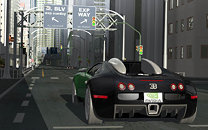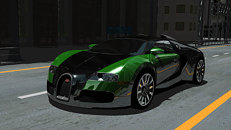Monday, August 18th 2008

NVIDIA Demonstrates Real-time Interactive Ray-tracing
Ray-tracing is the buzzword with consumer and professional graphics these days. It's a technique with which accurate representation of light with its behaviour in adherence with the laws of physics can be done when generating 3D computer graphics.
NVIDIA took ray-tracing to an interactive level with its work on an interactive real-time ray-tracing application. Currently NVIDIA has a larger stash of intellectual property in the field of ray-tracing than other players such as AMD or Intel, with the acquisition of MentalRay, a company that is pretty-much a standard in Hollywood.At the Siggraph 2008 event, NVIDIA demonstrated a fully interactive GPU-based ray-tracer, which featured real-time ray-tracing in 30 frames/second (fps) and a resolution of 1920 x 1080 pixels. The demo saw NVIDIA flex its muscle with using almost every element in ray-tracing for which technology has been developed so far, namely a two-million polygon demo, an image-based paint shader, ray traced shadows, reflections and refractions.
To maintain those 30 fps at a high display resolution, NVIDIA used four Quadro FX 5800 graphics cards working in tandem. These next-gen Quadro boards are based on GT200(b) GPUs, come with 240 shader processors and 4 GB of GDDR3 memory (for a total of 960 shaders and 16 GB of GDDR3 memory).
Source:
TG Daily
NVIDIA took ray-tracing to an interactive level with its work on an interactive real-time ray-tracing application. Currently NVIDIA has a larger stash of intellectual property in the field of ray-tracing than other players such as AMD or Intel, with the acquisition of MentalRay, a company that is pretty-much a standard in Hollywood.At the Siggraph 2008 event, NVIDIA demonstrated a fully interactive GPU-based ray-tracer, which featured real-time ray-tracing in 30 frames/second (fps) and a resolution of 1920 x 1080 pixels. The demo saw NVIDIA flex its muscle with using almost every element in ray-tracing for which technology has been developed so far, namely a two-million polygon demo, an image-based paint shader, ray traced shadows, reflections and refractions.
To maintain those 30 fps at a high display resolution, NVIDIA used four Quadro FX 5800 graphics cards working in tandem. These next-gen Quadro boards are based on GT200(b) GPUs, come with 240 shader processors and 4 GB of GDDR3 memory (for a total of 960 shaders and 16 GB of GDDR3 memory).


93 Comments on NVIDIA Demonstrates Real-time Interactive Ray-tracing
i think it looks like an old 1998 game cut scene
for me at least untill they can get the detail to the level of the wine glasses picture then ill be happy right now it looks worse than current graphics
Also, pretty obvious why nVidia did this demo. Kind of a "We can do it too!" type of message to Intel, their shareholders, and masses in general.
Just imagine wat games will look like when they get ray-tracing perfect. but wat im thinking is wat it will take to make it happen for us if it takes them 4 Quadro FX to maintain just 30fps? 16gb, dat means 8 4870X2? lol
After all this said, many people still miss the point.
If there is someone older on this forum, try to remember what was needed for 30 seconds of ray-traced animation 15-16 years ago...
I remember.
It took FOUR Silicon Graphics workstations rendering TWO WEEKS!
It is now done in real time.
So... It IS impressive! At least for me.
And GTA4 does not look better than this, I have yet to see a single reflection in GTA4, and the shadows look like complete ass.
And as for the power needed, yes, it is insane, and no where near reasonable. But the technology is still very young.
You know, HDR came into the world in a very similar way. It used to take a workstation with several graphics cards in it to render HDR, now we don't even think about it, it just happens.
Before ray-tracing has been done pre-rendered because of the massive amounts of calculations involved but to see that it can be done in 30fps is just amazing. Supposedly DX11 is going to support ray tracing in HAL.
And that is a tech demo, the goal was not to make a pretty image. It was for the people who can understand what 30 fps @1920x1200 in a 2 million poly scene means.
Also, you have to realize the images presented here ar 800x450, the demo was done at 1900x1080. There is a huge loss of quality just from the scaling of the images.